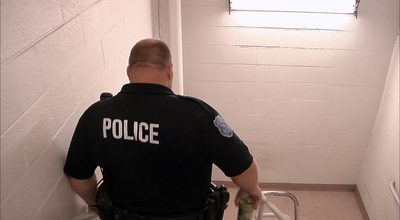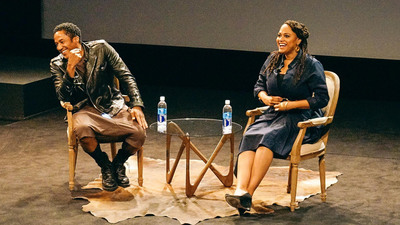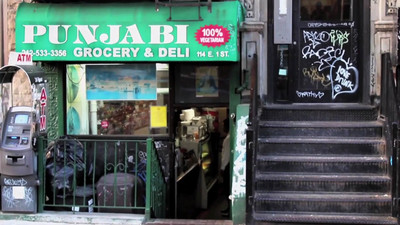
BY MATT BARONE |
WATCH: Mike Brown Would Have Been 19 Today
In this exclusive video premiere, three powerful artists come together in honor of the late Michael Brown and countless other unarmed black men who've lost their lives.
Last November, D'bi Young received an unexpected phone call. Its repercussions would be tremendously profound.
The caller was the Jamaican-Canadian dub poet's friend and one-time collaborator, Wade Hudson, a photographer/director who’d previously shot Young for the cover of the comic book Shemurenga: Black Supah Shero, for which Young supplied the title character's physical look. This time, though, Hudson didn’t have animated book pages on his mind. He brought up the nationally publicized death of Michael Brown, the unarmed black 18-year-old who’d been gunned down by white police officer Darren Wilson three months earlier, on August 9, in Ferguson, Missouri.

Hudson had just heard an original violin composition from acclaimed musician Andrew Forde, arranged in direct response to Brown’s passing. Hudson wanted Young to help him turn Forde's music into a post-Ferguson call-to-arms of some sort, though he wasn’t sure what it should be exactly. He left that up to Young.
"I was stunned at the request," says Young, "not because I found it strange but because I had spent the last few days ruminating on the events surrounding Ferguson and on the ongoing murder of black men, thinking to myself that I really should write something, say something." The mother of two little boys, Young had been struggling with how to address the tragedy. "Up until that point I was unable to write anything about what was going on," she recalls. "I couldn't put all that I was feeling into words. I couldn't organize my thoughts."
Once Forde’s music started playing, however, the inspiration rapidly surfaced. "About five seconds into it, I began to see and hear names of our dead behind us," says Young. "The more I listened, the more intense this roll call in my body and in my head became. I couldn't make out the names specifically but I heard them loudly and I knew they were names of people murdered by police. I began to weep."
Those tears eventually led to "In Whose Name?," an emotionally devastating video directed by Hudson and featuring both Young and Forde—he’s playing that aforementioned violin track, and she’s reciting the names of multiple innocent black men whose lives, like Michael Brown's, were ended prematurely and wrongfully. It’s a beautiful piece of work, steadily building in its visceral impact as Young’s commanding voice salutes a seemingly endless number of deceased black men, each name being exclaimed with more vigor than the last.
Young's pain radiates through the screen. "I wanted this video to be a moving portrait," says Hudson. "I chose to frame it almost identically to how I would shoot D’bi’s portrait. There’s a level of discomfort being that close to someone’s face and I wanted that to aid the message being delivered by forcing the viewer to stand uncomfortably close to the subject and confront the reality of the situation." As "In Whose Name" progresses, its tension rises. "We wanted to end at the peak of intensity because we see this as an escalating issue and didn’t feel comfortable with it coming to resolution or a decrescendo," says Hudson.
Today, May 20, marks what would have been Michael Brown’s 19th birthday, and we couldn’t think of a better way to honor his memory than by premiering "In Whose Name?" which you can watch above. And below, Hudson and Young reflect on how they channeled their grief into nearly three minutes’ worth of crushing visual and sonic power.
Coping With Tragedy Through Art...
"The killing of Trayvon Martin affected me in a profound way, and I think how I processed it was to suppress my emotion. Killings are now becoming more public and thus harder to ignore—I’m not sure I’ve found a way to process it completely."
"When the Michael Brown verdict was determined, I knew there would definitely be a feeling of guilt if I didn't respond. I choose to express myself not in words, but through imagery. My art is the first mode of public communication. I like to think that if we share our thoughts through art, we allow people to interpret their own meanings, think critically, and start safe conversations. Using creative expression can impact ignorance, or the default for ignorance, in society." —Wade Hudson
...Yet Art Isn't the Only Answer
"I don't believe that in difficult times we should have to choose between art and/or public protest. All kinds of activism, including art and public protest, need to be deployed in order to affect sustainable social change. I believe in a multiplicity of strategies because of systemic oppression's deep and nuanced levels of sophistication and complexity. I'm more concerned with us being clear about our motivations and intentions with making art and/or protesting. Violence begets violence. I ask myself, 'Is my intention to add more hate and violence to the world, or is my intention to add more love, resolution and peace to the world?'"
"There are serious considerations in the violence that we are witnessing. One, the unequal distribution of resources which has members of our human community living in deplorable conditions; two, violence is a globally sanctioned way of solving tensions among people, as witnessed with countries justifying waging war on people; and, three, legacies of imperialism and colonization are still being propagated, such as settlerism in North America. We cannot unpack these here, but I mention them to help us contextualize the brutality of black men."
"It’s not simply about the brutality of black men—it’s a complex set of overlapping and interconnected systems and cycles of oppression that keep 'man-made' borders such as countries and nations intact. Our strategies, or solutions, therefore also need to be overlapping and interconnected." —D’bi Young
We're All Violent by Design
"I’m beginning to understand, through careful introspection, that the violence I reject in the public space is also the violence that I inhale and exhale through my own body. I’m realizing that I'm not outside of the violence that I critique. Violence is very much a part of my own human make-up. I think of how I treat my sons, my friends, and my colleagues, and the ways in which I perpetuate the micro-violence that emerges from my emotional fluctuations/confusion. I wonder to myself, ‘What roles do emotional fluctuations/confusion play in a police officer's body when he exists in a system that rewards him, encourages him, and conditions him to believe that black bodies do not deserve compassion?” I wonder how he negotiates his emotions."
"'In Whose Name' is another way of responding that allows me to help humanize the dialogues we’re currently having about violence. It’s challenging to talk about the multiple ways in which systemic oppression is entrenched in our lives. Seeing black men and women dead at the hands of police hurts our hearts and our souls; people murdering other people makes our spirits cry out, especially as we recognize that there’s a continuum from slavery through to today where these rituals of violence against black bodies never stopped."
"'In Whose Name' reminds us that love sits at our core, even while we ourselves are stirred to violence because we can't take it anymore and our hearts are repeatedly breaking. We recognize ourselves in the names of our dead." —D’bi Young
Social Responses Run Deeper Than Twitter and Facebook
"The goal here is to do more than a hashtag and to break through patterns of apathy towards murder at the hands of police. I’d like to start a conversation with everyone but specifically with artists. I’d love this piece to inspire other creative people to use their talents for something meaningful, not just something for more ‘Likes.’ For this piece we have such an amazing blend of talent, poetry, musicians, sound engineers, makeup, and cinematography. The fight for a safer society starts with collaboration." —Wade Hudson
"We stand on the shoulders of those who came before us. We’re all part of a collective humanity, so a crime against one is a crime against all. If 'In Whose Name' touches someone, it’s because, deep inside, they carry a profound love, and it’s that love that we will need to re-imagine a more just world. That world begins with you and I." —D’bi Young

